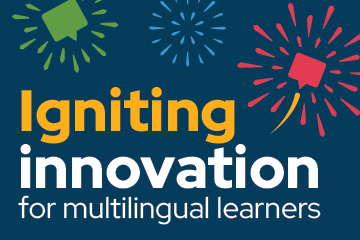Resources/Recursos
Featured Resources



All resources/Todos los recursos
Filter resources by:
Resources/Recursos
WIDA ELD Standards Framework, 2020 Edition - Grade 1 Materials
This resource includes the grade 1 materials that are part of the WIDA English Language Development Standards Framework, 2020 Edition. The materials specific to this grade level have been pulled together to provide educators of students in grade 1 with a smaller, more manageable booklet to support their implementation of the WIDA ELD Standards Framework in their classroom.
Resource Details View Download NowReleased October 2021
WIDA ELD Standards Framework, 2020 Edition - Grades 2-3 Materials
This resource includes the grades 2-3 materials that are part of the WIDA English Language Development Standards Framework, 2020 Edition. The materials specific to this grade-level cluster have been pulled together to provide educators of students in grades 2-3 with a smaller, more manageable booklet to support their implementation of the WIDA ELD Standards Framework in their classroom.
Resource Details View Download NowReleased October 2021
WIDA ELD Standards Framework, 2020 Edition - Grades 4-5 Materials
This resource includes the grades 4-5 materials that are part of the WIDA English Language Development Standards Framework, 2020 Edition. The materials specific to this grade-level cluster have been pulled together to provide educators of students in grades 4-5 with a smaller, more manageable booklet to support their implementation of the WIDA ELD Standards Framework in their classroom.
Resource Details View Download NowReleased October 2021
WIDA ELD Standards Framework, 2020 Edition - Grades 6-8 Materials
This resource includes the grades 6-8 materials that are part of the WIDA English Language Development Standards Framework, 2020 Edition. The materials specific to this grade-level cluster have been pulled together to provide educators of students in grades 6-8 with a smaller, more manageable booklet to support their implementation of the WIDA ELD Standards Framework in their classroom.
Resource Details View Download NowReleased October 2021
WIDA ELD Standards Framework, 2020 Edition - Grades 9-12 Materials
This resource includes the grades 9-12 materials that are part of the WIDA English Language Development Standards Framework, 2020 Edition. The materials specific to this grade-level cluster have been pulled together to provide educators of students in grades 9-12 with a smaller, more manageable booklet to support their implementation of the WIDA ELD Standards Framework in their classroom.
Resource Details View Download NowReleased October 2021
Marco ALE: Aplicación para la actualización y desarrollo de estándares
Marco de referencia de las artes del lenguaje del español de WIDA: Aplicación para la actualización y desarrollo de estándares is the first Spanish language arts framework of its kind in the United States. This document serves as a guide to learn more about the elements of Marco ALE and how to apply them in the enhancement, development, and alignment of Spanish language arts standards.
Written in Spanish with English summaries
Resource Details View Download NowReleased October 2021
Making Connections (Maryland)
Making Connections: Using the Maryland Early Learning Standards and WIDA Early Years Resources to Plan Instruction for Young Multilingual Children is a comprehensive resource that offers suggestions, tools, and sample plans for teachers who use the Maryland Early Learning Standards and WIDA resources to plan equitable learning opportunities for young multilingual children.
Resource Details View Download NowReleased September 2021
Making Connections (Wisconsin)
Making Connections: Using the Wisconsin Model Early Learning Standards and WIDA Early Years Resources to Plan Instruction for Young Multilingual Children is a comprehensive resource that offers suggestions, tools, and sample plans for teachers who use the Wisconsin Model Early Learning Standards and WIDA resources to plan equitable learning opportunities for young multilingual children.
Resource Details View Download NowReleased September 2021
Making Connections (Alabama)
Making Connections: Using the Alabama Early Learning and Development Standards and WIDA Early Years Resources to Plan Instruction for Young Multilingual Children is a comprehensive resource that offers suggestions, tools, and sample plans for teachers who use the Alabama Early Learning and Development Standards and WIDA resources to plan equitable learning opportunities for young multilingual children.
Resource Details View Download NowReleased August 2021
Making Connections (Illinois)
Making Connections: Using the Illinois Early Learning and Development Standards and WIDA Early Years Resources to Plan Instruction for Young Multilingual Children is a comprehensive resource that offers suggestions, tools, and sample plans for teachers who use the Illinois Early Learning and Development Standards and WIDA resources to plan equitable learning opportunities for young multilingual children.
Resource Details View Download NowReleased August 2021
Making Connections (Connecticut)
Making Connections: Using the Connecticut Early Learning and Development Standards and WIDA Early Years Resources to Plan Instruction for Young Multilingual Children is a comprehensive resource that offers suggestions, tools, and sample plans for teachers who use the Connecticut Early Learning and Development Standards and WIDA resources to plan equitable learning opportunities for young multilingual children.
Resource Details View Download NowReleased August 2021
What can collaboration look like with the WIDA ELD Standards Framework?
Collaboration is one of the four Big Ideas of the WIDA ELD Standards Framework. This two-page "comic" strip shows the story of how a science teacher and an ESL teacher work together on their multilingual learners' language development and ways of meaningfully engaging with the content of a science unit. This step-by-step example can be used in tandem with Section 4 of the WIDA ELD Standards Framework, 2020 Edition, that has a more detailed look at the collaborative planning process.
Resource Details View Download NowReleased July 2021
Putting It All Together: Next Steps for Using the 2020 Edition
In this webinar, the WIDA standards development team discusses and models the tools, provided in the 2020 Edition, for initiating critical conversations with school leaders and colleagues.
Resource DetailsReleased March 2021
WIDA English Language Development Standards Framework, 2020 Edition
The WIDA English Language Development (ELD) Standards Framework, 2020 Edition: Kindergarten – Grade 12 is a document that provides a foundation for curriculum, instruction and assessment for multilingual learners in kindergarten through grade 12. The ELD Standards Framework is centered on equity and fosters the assets, contributions, and potential of multilingual learners. The 2020 Edition serves as a resource for planning and implementing language instruction and assessment for multilingual learners as they learn academic content.
Grade level cluster-specific versions of the 2020 Edition are also available.
Resource Details View Download NowReleased February 2021
Curricular Considerations: Introduction to Collaborating Around the 2020 Edition
The WIDA ELD Standards Framework, 2020 Edition brings new practical ways for all educators working with multilingual learners to conceptualize the development of content and language together through asset-based, equitable, and rigorous approaches in curricular design. This session will encourage participants to think about what collaboration looks like in these contexts.
Resource DetailsReleased February 2021
Introduction to the Updated Key Language Uses
One of the components of the WIDA ELD Standards Framework is the Key Language Uses (KLUs). The KLUs summarize the most prominent language uses across disciplines, helping educators organize and prioritize curriculum and instruction. Learn about the updated KLUs – Inform, Narrate, Explain and Argue.
Resource DetailsReleased February 2021
Introduction to the 2020 Edition
Members of the WIDA standards development team share a high-level overview of what’s new and exciting in the WIDA English Language Development Standards Framework, 2020 Edition. Intended for SEA representatives, district leaders, and EL and content teachers.
Resource DetailsReleased January 2021
Introduction to the WIDA ELD Standards Framework, 2020 Edition
This video provides an introductory overview of the WIDA English Language Development Standards, 2020 Edition. It briefly highlights how the 2020 Edition is centered on equity and fosters the assets, contributions, and potential of multilingual learners.
Resource DetailsReleased December 2020
Educación en el mundo actual
This Focus Bulletin offers strategies for advancing equity in bilingual settings during the mundo actual of COVID-19. The bulletin emphasizes the importance of valuing multilingual learners’ linguistic and cultural diversity, using translanguaging, and leveraging technological resources.
Published August 2020
Authors: Sam Aguirre, Erika Rosales
Released August 2020
Oral Language in the Classroom
This Focus Bulletin explores the kind of spoken English language that multilingual learners benefit from developing, showing how that oral language is described in WIDA standards resources and assessed on the ACCESS for ELLs Speaking test.
Published October 2019
Authors: Mark Chapman, Dale Erlandson
Released November 2019




